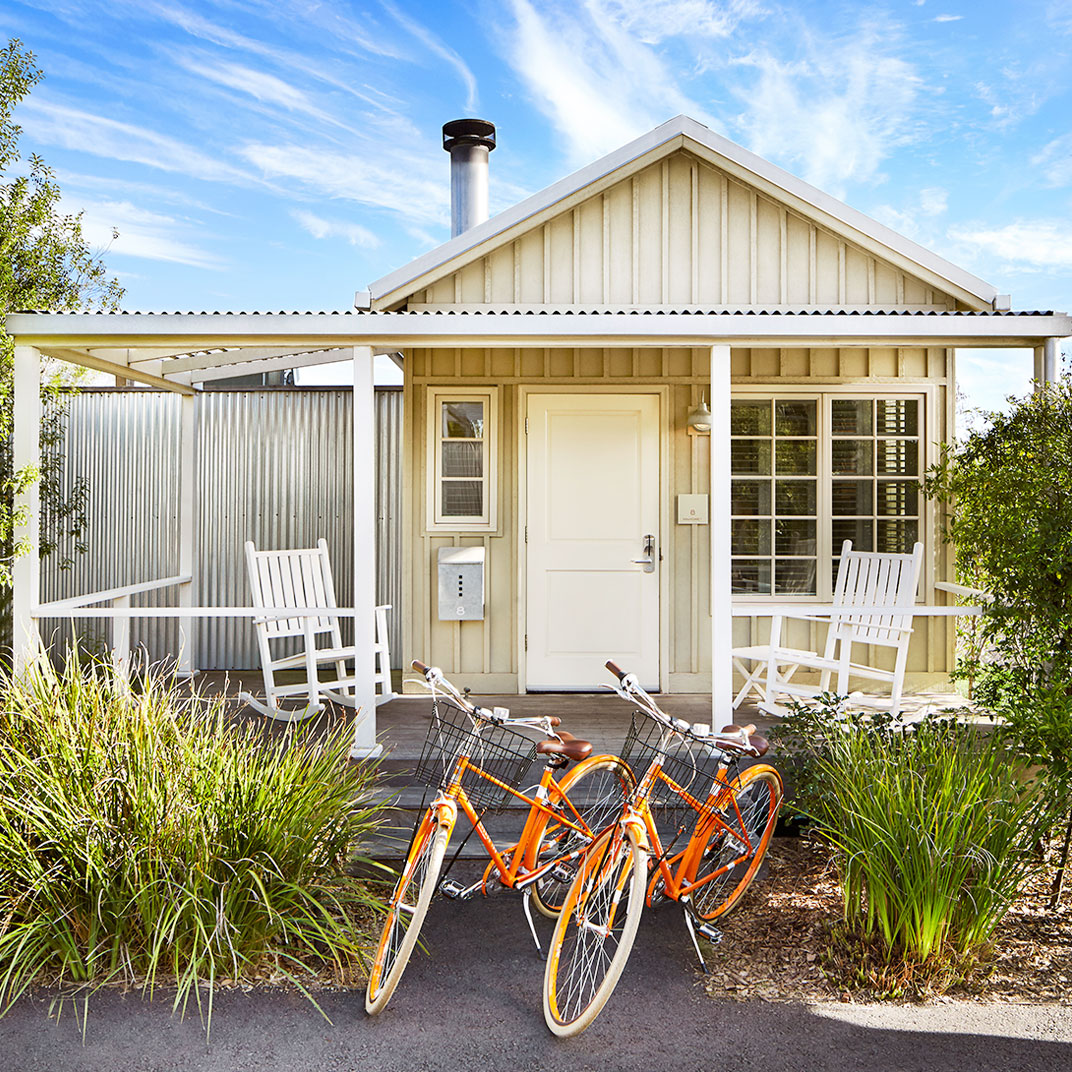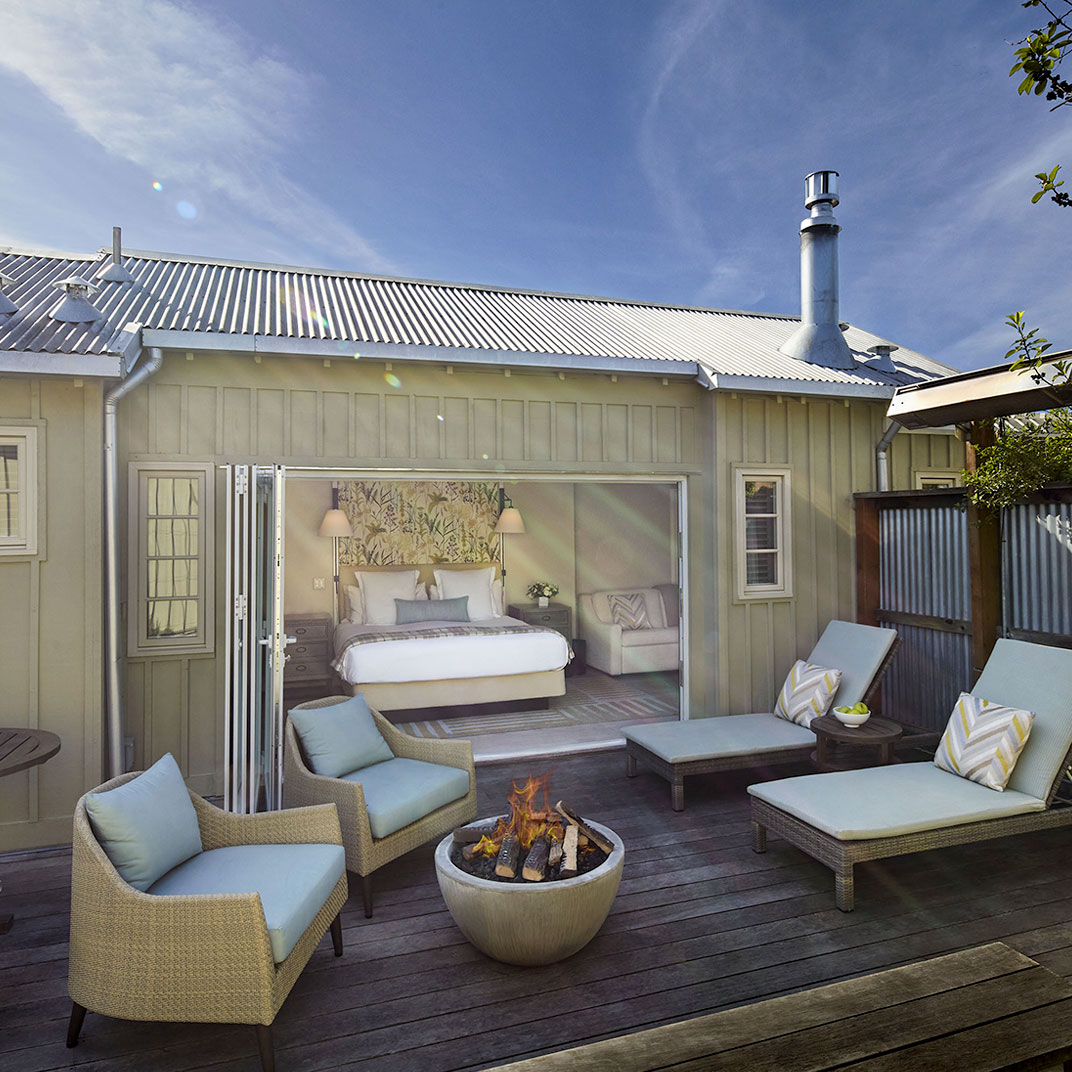January 11, 2023
Tablet is your source for discovering the world’s most exciting boutique hotels — places where you’ll find a memorable experience, not just a room for the night. For over twenty years we’ve scoured the earth, evaluating hotels for every taste and budget, creating a hand-picked selection that’s proven and unforgettable. Now, we’re the official hotel selection of the legendary MICHELIN Guide.
Here are the top 10 boutique hotels in California’s Napa and Sonoma Counties.
Finally a break from the Tuscan-Provençal style that seems to dominate the California wine country. Carneros Resort and Spa, at the south end of Napa, close to San Francisco, is rather more modern, its style a sort of rustic minimalism, its inspiration seemingly drawn not from Europe but from the American Midwest and Northeast.


It’s the buildings that people tend to either love or hate about Carneros. The corrugated metal roofs of the cottages are striking and unassuming at the same time, and fit well into the landscape of rolling hills and wide-open farmland. Once inside, though, it’s difficult to find fault — while not as over-the-top as some wine country accommodations, the cottages are simple, tasteful, and more than luxurious enough, with the full range of modern electronics, splendid indoor-outdoor showers, and private garden patios, complete with gas heaters for cool California nights.
We’ve talked at great length in these pages about the perplexingly insecure tendency of California wine country hotels to imitate backward-looking Tuscan or Provençal forms, so it’s only fair we give credit to those that are comfortable locating themselves in present-day California. Harmon Guest House is one of these — this ultra-modern boutique hotel in the heart of Healdsburg was designed by San Francisco architect David Baker, and like all the best in modernist-inspired architecture, it couldn’t have been built anywhere else.


Raw concrete construction can feel cold, but here it’s warmed up by the contrast with the organic materials used elsewhere, from the reception desk, made from a fallen eucalyptus tree, to the building’s façade, a screen made of reclaimed redwood slats that serves as a sun shade. Hickory furniture and locally made tiles do the same for the rooms and suites, which are furnished with luxe must-haves like Nespresso machines and Tivoli sound systems.
Several towns in California’s Napa and Sonoma Valleys have a legitimate claim on the title of America’s culinary capital, and St. Helena, home of the West Coast branch of the Culinary Institute of America, is a strong contender. These days it’s also home to one of the California wine country’s most rarefied — and wine-obsessed — hotels. Meadowood Napa Valley was a country club first, a winemaking estate second, and only recently has it emerged as an absolutely first-rate luxury resort.


It’s certainly got all the building blocks. The setting, on the fringes of St. Helena, affords plenty of privacy to the rooms, suites, and cottages, all of which are outfitted in a spare, elegant, residential style, and which range from rather large to downright sprawling. All come with fireplaces, essential for those cool Northern California nights, as well as all the expected luxury trimmings, from queen or California King beds with down bedding to Molton Brown bath products, in-room espresso machines, and the full suite of electronic conveniences.
Just three or four decades on from the beginning of the great Northern California wine boom, and finally a local style is emerging. Italian and French architecture made sense in the early years, when the wineries of the Napa and Sonoma valleys were still striving to be taken as seriously as their European counterparts. But today’s California has a homegrown architectural tradition, a fine example of which is downtown Healdsburg’s decidedly modern h2hotel.


No longer does it take a villa, you could say, to signify a wine-country hotel. H2hotel makes the most of a striking modernist form by the San Francisco architect David Baker, who’s in full urban-rustic mode here; the geometric shapes and large blocks of color are tempered by an undulating, wave-shaped green roof on the one hand, and some cheeky little Italian-style balconies on the other.
Northern California’s wine country has no shortage of lodgings—seemingly every third house is a bed and breakfast. Hotel Healdsburg, though, is something unique; this full service luxury hotel bucks the faux-rustic trend in favor of sleek modern design.


Guest rooms are spacious and smartly decorated, with wood floors and Tibetan rugs, and most open through French doors onto private balconies with views of the town square or the hotel gardens. Bathrooms are impeccably designed, modern, with six-foot soaking tubs of grey stone and separate walk-in showers. Comfort, obviously, is key, evident from the Frette bathrobes and goose down duvets. If you want to go all out, visit the Couples Suite in the spa, offering a double-size soaking tub and a pair of in-room massage tables.
Not exactly a household name, Forestville lies some ways off the most heavily beaten path of the Napa/Sonoma wine country, partway from Santa Rosa to the Russian River town of Guerneville. As such it’s something of an escape within an escape, a break not just from the city but from all the commotion on the winery-and-restaurant circuit. This is a town where a farmhouse inn, despite its French restaurant, doesn’t have to have a French name, or really much of a name at all — it’s just the Farmhouse Inn.


You’re close enough to partake in all that you wish. But you’re also comfortably ensconced in six idyllic acres, on an estate comprising of just eighteen rooms, suites and cottages. The main house is an authentic 19th-century farmhouse, but the interiors are crisply, coolly contemporary. Comfort is key: expect feather-topped beds and fine linens, and bathrooms with jetted tubs and either steam showers or saunas.
The Madrona may be new, but the Mansion, the hotel’s ornate centerpiece, certainly isn’t — this 1881 mansion was built in Aesthetic Movement style, and stands in stark contrast to the Tuscan and Provençal pretensions of so many other wine-country hotels. It’s set on the west side of Healdsburg, just across Dry Creek from the town center, and its extravagant silhouette isn’t the only surprise for arriving guests; the interiors, by co-owner and designer Jay Jeffers, are eclectic, incorporating period elements as well as modern interventions, a very fine art collection, and a boatload of antiques and curios collected during several lifetimes’ worth of travels.


Rooms and suites are divided between the original mansion, its carriage house, and a handful of restored 19th-century bungalows. They’re all different, and all packed with throwback romance and modern comforts. And they’ve all got access to the Madrona’s impressive facilities: a lovely outdoor pool, a gym furnished with Peloton bikes and Tonal gear, a fleet of Van Moof electric bikes, and a guests-only lounge. Meanwhile guests mingle with the public at the Madrona’s restaurant, where the Michelin-starred chef Jesse Mallgren presides over a wide-ranging all-day menu, crafted from seasonal ingredients (many grown in the hotel’s own garden) and served in the dining room, on the terrace, or just about anywhere else.
A decade or two ago, Napa Valley was the place to go for a little slice of Renaissance Tuscany. It made sense at the time, with the California wine industry really hitting its stride, for the architecture to aspire toward a classic European sort of gravity. These days, however, Napa is ground zero for a new green building movement, and its hotels are leading the way — no doubt something greener will come along, but at the time of its opening, Bardessono was pretty much as sustainable as it gets.


The construction, which looks like sandstone or blond concrete, is actually rammed earth — for several slightly boring reasons it’s greener than all the alternatives, and anyway it lends a distinctive look. You’ll see a lot of wood as well — when sourced properly it’s the other green building material, and most of it is reclaimed or recycled. And it’s not just the building that’s green, but the operation — great unglamorous pains are taken to reduce paper or water waste, to automatically shade the rooms from the midday sun, that sort of thing.
While no part of Napa Valley is what you’d call a food desert, there’s a case to be made for Yountville as the culinary capital of the region — and, therefore, quite possibly the whole country — thanks to a star-studded collection of restaurants, of which the French Laundry is only the most famous. And while its hotels may be less storied, that’s changing. Vintage House is a thorough re-imagining of an earlier hotel, and in its new incarnation it’s one of Napa Valley’s most impressive luxury hotel — a category that poses some stiff competition.


It’s set on 22 acres of land, and its 80 rooms and suites are divided into a number of smaller buildings, which only intensifies the feeling of pastoral seclusion. And while the European influence that’s so familiar elsewhere in Napa is present here, it’s balanced by a bright simplicity in the guest-room décor that feels perfectly Californian. The humblest Deluxe rooms are lavish enough for most people’s purposes, and the bungalow-style Villa Suites are nothing short of extraordinary. Cap it off with the fact that you’re within walking distance of a handful of Michelin-starred restaurants and the experience is one you’d be hard pressed to improve upon.
The original Napa Valley luxury boutique hotel, Auberge du Soleil, three decades on, is still going strong — so strong that, for many repeat guests, there simply isn’t anywhere else. They come for the setting, with views over endless vineyards and olive groves; they come for the hotel, which is effortlessly, unpretentiously luxurious; and they come, most of all, for the restaurant, which stands out as something special even in Napa Valley, a region that’s arguably America’s culinary capital.


In true French style, the restaurant came first, with rooms provided as an added inducement for diners to drive those last few miles to Rutherford. Today they’re anything but an afterthought. A recent renovation has brought them subtly up to date, but they’re true to the Auberge’s Provence-meets-Napa inspiration, sunny and warm, with glass walls or French doors opening the spaces up to the outdoors via a private terrace — it’s worth springing for the valley view, but there isn’t a disappointing room in the house.
For a family getaway in Napa or Sonoma, we recommend the following boutique hotels:.
Carneros Resort & Spa
The Meritage Resort & Spa
Calistoga Motor Lodge & Spa
Timber Cove Resort
When it comes to Napa and Sonoma, you have plenty of boutique hotel options with swimming pools. Here’s a handful:
Auberge du Soleil
Carneros Resort & Spa
Montage Healdsburg
Gaige House
When it comes to a romantic spot for a special occasion in Napa or Sonoma, we would urge you to consider the following boutique hotels.
The Madrona
Farmhouse Inn
The Kenwood Inn and Spa
Rancho Caymus Inn
Visiting a winery is one of the must-do activities in Napa and Sonoma. The following boutique hotels give a great home base:
Hotel Yountville
Milliken Creek Inn
Four Seasons Resort Napa Valley
Calistoga Motor Lodge & Spa
El Dorado Hotel
Many boutique hotels in Napa and Sonoma take their spas extremely seriously. Here are several stand-outs:
Meadowood Napa Valley
Bardessono
Hotel Villagio
Vintage House
Harvest Inn
Copyright © Tablet Inc 2023. All rights reserved.
Our privacy & data usage policies.